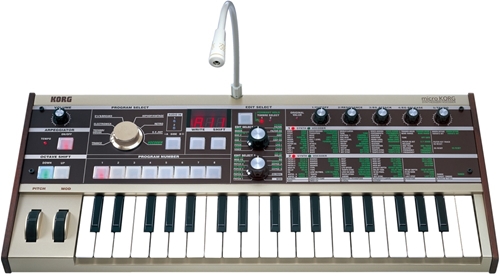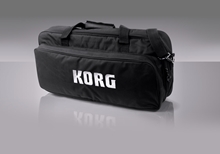KORG MicroKorg Analog Modeling Synth
A compact-sized synthesizer that delivers the true enjoyment of synthesis.
A true synthesizer with an analog modeling tone generator.
The microKORG is a serious yet compact synthesizer with a strong personality, designed to give you the true enjoyment of creating sounds. The tone generator features the same DSP analog modeling system as the MS-2000 – which has been acclaimed by musicians for its warmth and broad range of sounds. Offering a wide selection of waveforms, the microKORG offers powerful filters, envelopes, LFOs, effects and modulation possibilities to help you shape the sounds you want. You can edit the sound easily and intuitively, simply by selecting parameters and turning knobs. Since it's easy to modify the sound in realtime, the microKORG can play a role in a wide variety of situations ranging from live performance, to recording, to computer control.
Each voice of the microKORG consists of two oscillators (OSC1 and OSC2). OSC1 provides basic analog waveforms such as sawtooth wave, square wave, and sine wave, as well as VOX Wave (human voice formats) and 64 DWGS waveforms from Korg's classic DW-8000 digital synthesizer. This is a total of 71 possible selections, more than any other modeling synthesizer! Many of these waves can be further shaped to produce classic effects like pulse width modulation, FM and other forms of waveshaping. By applying ring- or sync-modulation from OSC2 with its three basic analog waveforms, you can easily create extremely complex sounds that would be impossible using just a single oscillator. An external audio input can be used to route audio into the microKorg and process it with the filter and effects sections.
Eight oscillator types:Sawtooth wave, square wave, triangle wave, sine wave, Vox wave, DWGS x 64, Noise, Audio In
The multi-mode filter of the microKORG lets you choose from two types of low-pass filter (-12 dB/-24 dB), a band-pass, or a high-pass filter. Filter resonance can be adjusted to emphasize a frequency peak, and will self-oscillate if desired. These extremely sharp filters give you the versatility to create any tone from traditional fat sounds to cutting dance sounds.
The EG (Envelope Generator), which applies time-variant change to the sound parameters, is a classic ADSR design (Attack, Decay, Sustain, and Release), and can also be used as a modulation source. Two types of LFO (Low Frequency Oscillator) are provided, letting you apply cyclic modulation to the sound parameters. High-speed DSP processing ensures that vibrato, wah, and tremolo effects are produced very smoothly.
You can connect a mic to the AUDIO IN1 jack of the microKORG, and use it for a powerful vocoder that applies the tonal character of a vocal input to the sound of an oscillator, producing the impression that it is speaking or singing. This is an eight-band vocoder (the sixteen filters are used in pairs) that can not only simulate the classic vocoder sounds of the past, but also shift the filter frequencies (Formant Shift function) or even adjust the level and panning of each frequency band to dramatically transform the tonal character and create highly original sounds. In addition, the Formant Hold key freezes the formants of the input vocal signal, allowing you to capture your voice and play it on the keyboard. Since the microKORG ships with a microphone, you can start using the powerful vocoder function immediately.
The microKORG contains 128 programs covering a wide range of current and classic synth and vocoder sounds. From the warm and rounded tones characteristic of analog modeling, to sharp and extreme sounds, you can easily access the sounds you need, thanks to the clear genre categories that the sounds are organized by. Just select the music style/sound category you want and pick a sound! Once you select a sound the five knobs will control the most important functions you would want in performance for immediate results.
MIDI controller functionality. The microKORG is perfect for use in a computer-based music production setup. Since the five knobs on the panel can transmit MIDI messages (control changes), they can be used as controllers for software synthesizers. You can use its 37-note velocity-sensitive mini-keyboard for recording into your sequencer. And of course the microKORG can be used as an external sound module with powerful synthesizer and vocoder functionality. Thanks to its small size and battery-powered operation it’s the ideal match for use with portable notebook computer systems.
SPECIFICATIONS
- Sound Generation Method: Analog Modeling Synthesis System
- Synthesizer Program: Multi Timbral=2 (max, Split/Dual Mode), Voices=4 voices
- Programs: 128 programs
- Effects: Modulation effects (3 types), Delay (3 types), Equalizer
- Arpeggiator: 6 types
- Keyboards: 37 Keys (mini-keyboard, keyboard has velocity)
- Inputs: AUDIO IN 1,2, Level switch LINE/MIC, [AUDIO IN 1, 2 (LINE) ], [AUDIO IN 2 (MIC)]
- Outputs: L/MONO, R, Headphones
- MIDI: IN, OUT, THRU
- Display: 3 characters×1 line with 8 segment LED
- Power Supply: DC 9 V (AC adapter), or six AA alkaline batteries (sold separately)
- Dimensions: 524(W)x232(D)x70(H)mm/20.63"(W)x9.13"(D)x2.76"(H)
- Weight: 2.2 kg/4.85 lbs. (without batteries and included microphone)
- Accessories: AC adapter (DC 9 V, 600 mA), Condenser Microphone






